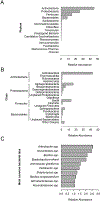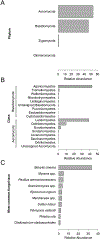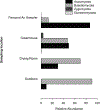Microbial hazards during harvesting and processing at an outdoor United States cannabis farm
- PMID: 29370578
- PMCID: PMC6314012
- DOI: 10.1080/15459624.2018.1432863
Microbial hazards during harvesting and processing at an outdoor United States cannabis farm
Abstract
Cannabis cultivation is an emerging industry within the United States. Organic dust derived in part from naturally occurring microorganisms is known to cause byssinosis in the hemp industry. In this pilot study, bacteria and fungi encountered by workers at an outdoor cannabis farm that utilized organic practices were elucidated by 16 S ribosomal RNA (rRNA) and Internal Transcribed Spacer (ITS) region sequencing, respectively. Area (n = 14) and personal air samples (n = 12) were collected during harvesting and processing activities. 16 S rRNA and ITS regions of extracted bacterial and fungal genomic DNA were amplified and sequenced using Sanger sequencing. Bacterial sequencing resolved 1,077 sequences that were clustered into 639 operational taxonomic units (OTUs) and predominantly placed in the phylum, Actinobacteria (46%). Personal air samples revealed higher bacterial and Actinobacteria diversity compared to outdoor area samples collected within the facility (p < 0.05). A high degree of dissimilarity between bacteria was identified within and between samples. Fungal sequences (n = 985) were identified and predominantly clustered in the phylum Ascomycota (53%). Of the 216 fungal OTUs elucidated, the cannabis plant pathogenic species, Botrytis cinerea, was the most prevalent and accounted for 34% of all fungal sequences. The relative abundance of B. cinerea was highest in personal air samples (59%) compared to area samples collected in the drying room (19%), greenhouse (18%), and outdoor environment (6%). There was 49% sample similarity between fungi identified within personal air samples, but higher dissimilarity coefficients were observed within and between greenhouse, drying room, and outdoor area air samples. The results of this pilot study suggest that the cannabis farm workers are potentially exposed to Actinobacteria as well as the cannabis plant pathogen, B. cinerea during harvesting, bud-stripping, and hand-trimming processes.
Keywords: Bacteria; cannabis; exposure assessment; fungus; gene sequencing; occupational hazards.
Figures





References
-
- Jensen EL, and Roussell A: Field observations of the developing legal recreational cannabis economy in Washington State. Int J Drug Policy 33: 96–101 (2016). - PubMed
-
- Hall W, and Degenhardt L: Adverse health effects of non-medical cannabis use. Lancet 374(9698): 1383–1391 (2009). - PubMed
-
- Fishwick D, Allan LJ, Wright A, and Curran AD: Assessment of exposure to organic dust in a hemp processing plant. Ann Occup Hyg 45(7): 577–583 (2001). - PubMed
-
- Martyny JW, Serrano KA, Schaeffer JW, and Van Dyke MV: Potential exposures associated with indoor marijuana growing operations. J Occup Environ Hyg 10(11): 622–639 (2013). - PubMed
-
- Herzinger T, Schopf P, Przybilla B, and Rueff F: IgE-mediated hypersensitivity reactions to cannabis in laboratory personnel. Int Arch Allergy Immunol 156(4): 423–426 (2011). - PubMed
Publication types
MeSH terms
Substances
Grants and funding
LinkOut - more resources
Full Text Sources
Other Literature Sources
Medical
